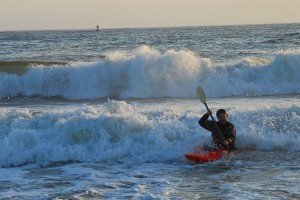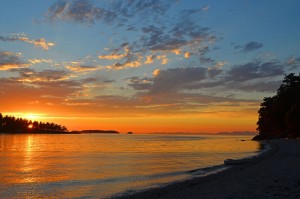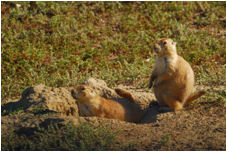Kauai, the Garden Island, is a wonderful vacation destination for nature lovers. As absolute lovers of nature, my wife Mary and I had contemplated a trip to Kauai for years. Somehow, we managed to visit all the other major islands first (Maui, the Big Island and Oahu) due to cheaper airfares and/or more direct routes. We finally splurged and spent eight glorious days in Kauai. I’m very glad we did.
My idea of a tropical vacation includes secluded beaches, waves, snorkeling, and beautiful scenery. We found all of those in Kauai, and more. On beaches, people reach meditative states effortlessly, and we did, soothed by the sun, sand and sound of waves. If you don’t have the opportunity for a tropical vacation, try this Beach Visualization Meditation.
Rather than rambling on about each day of our trip, I’m going to share some highlights, in hopes they’ll inspire and inform.
Nightlife
There probably is one, but I’m not sure. Our nightlife consisted of having a glass of wine on our lanai and going to bed early, so we could get up before sunrise the next morning. I may have this backwards. Maybe we went to bed early, because we were so tired from getting up before sunrise in order to fit in as much hiking, snorkeling and exploring as we could.
Our second floor lanai actually sat directly above the poolside bar, at Islander on the Beach. We never even got around to having a drink at that bar, but it did sound like a few people were having fun there. They were quiet enough to be drowned out by waves crashing on the beach. If nightlife is a big priority, you should probably go to a different island. There is an article covering the 10 Best Bars on Kauai, none of which we made it to.
Restaurants and Food
I don’t know much about restaurants on Kauai either. As budget travelers, our first stop was Costco and a grocery store, where we bought enough food to take us through most of the week. Farmer’s markets are popular on Kauai, so we picked up some fresh produce at one. We did have a few meals at the Island Country Market deli, across the street from our condo project. That doesn’t really count as a restaurant, but they had good, reasonably priced food. Actually, we also had a nice Italian dinner at Bobbie V’s and delicious coconut shrimp at the Shrimp Station in Kapaa. Now that I’ve covered the stuff that I don’t know much about, I’ll dig into the important stuff, like hiking trails and beaches.
Hiking Trails
Now this is where Kauai excels. There are many fine trails with some spectacular scenery. If you want an idea of the kind of scenery you might encounter, consider some of the countless movies that were filmed on Kauai, including: the Jurassic Park movies, Donovan’s Reef, South Pacific, Blue Hawaii, Pirate of the Caribbean, Lord of the Flies, Tropic Thunder, Raiders of the Lost Ark, Fantasy Island, George of the Jungle, King Kong, and many more. If you recall these movies, you might have surmised that there is lots of lush tropical jungle on Kauai. There is, along with miles of sandy beaches, rocky shorelines, craggy inland cliffs and a vast variety of plants and birds.
Speaking of birds, there is no avoiding the thousands of roosters and chickens on Kauai. They’re everywhere. Apparently, hurricanes destroyed chicken coops in 1992. The chickens bred with red junglefowl, brought over by the Polynesians. Now, you encounter chickens in the jungle, in parking lots, and on the beach. While sleeping on Poipu Beach, Mary had a chicken and her little chicks running around by her legs, then over to a neighboring beach chair, where they hid under the person sitting in it. They are quite entertaining to watch, and since we were up before dawn most days, the rooster crowing didn’t bother us. They’re actually quite entertaining to watch.
Hikes we did:
Waimea Canyon Trail
On our first full day, we planned to drive to the end of Waimea Canyon Road and hike the Pihea Trail, with stunning views looking down on Kalalau Valley and the blue waters of the Pacific. When we reached the trailhead, we found ourselves inside a misting rain cloud, with a wet, slippery red clay trail. So much for that. We headed six or so miles back down the road to the Waimea Canyon Lookout. The Waimea Canyon Trail took us to waterfalls deep in Waimea Canyon, a 3000’ deep gorge known as Grand Canyon of the Pacific, carved out by the Waimea River.
Mahaulepu Heritage Trail
The trail starts at Shipwreck Beach, tucked between the Grand Hyatt Hotel and Poipu Bay Golf Course. The beach is popular with surfers, boogie boarders, and cliff jumpers. The trail itself climbs from the sandy beach up onto cliff tops, following a spectacular rocky shoreline. Part of the trail collapsed into the sea, so the hike took us along a fairway of the golf course, with mountain views over the golf course one side and waves crashing into cliffs on the other.
Sleeping Giant Trail
This trail was a mere six minute drive from our condo in Kapaa. It climbs to a mountain top with panoramic views of the whole east side of Kauai, along with miles of the Pacific. Near the top, there a hole through a cliff, known as the eye, a great natural frame for photos.
Kalalau Trail
One of our goals, in going to Kauai, was to hike the famous Kalalau Trail, along the Napali Coast. According to the Huffington Post, it’s “hands down the most incredible hike in America.” Unfortunately, I had no idea how difficult it is to get a permit to hike more than the first two miles of this trail. We never got one.
The trail starts at the end of the road, in the northwest corner of the island. On the short part of the trail we covered, we did reach the very scenic viewpoint featured in the Huffington Post article.
Kuilau Ridge Trail
This trail is a real jungle hike, following a ridge and looking down into lush valleys. We did this hike on the rainiest day of the trip, slogging through mud. The weather did seem to add to the jungle feel.
Smith Family Garden
This really is more of a relaxing stroll through a botanical garden setting, with mountain views, all sorts of plants, and possibly even more birds. I bought a couple bags of cracked corn and held some out in my hand. Zebra doves swooped down and literally piled up on my arm, trying to get at the corn. For some strange reason, I had a hard time convincing Mary to try it. All the birds following us reminded me of that old Alfred Hitchcock movie, The Birds.
Beaches and Snorkeling
There are a lot to choose from. We managed to arrive during an unusually cool and cloudy stretch of weather, with plenty of sporadic rain, so we checked weather forecasts and often based our destination for the day on seeking sunshine. Weather varies a lot on Kauai. Polihale Beach (southwest) seems to get the most sun, followed by Poipu (South). Our location on the east side of island is reasonably dry, and the lush north shore gets more rain, but it doesn’t come close to Mt Wai’ale’ale, one of the wettest places on earth with an average of 374 inches of rain per year.
Like I mentioned under “Restaurants and Food,” Costco was one of our first stop. The local Costco also carries a variety of beach gear at very reasonable prices. They have boogie boards, snorkeling sets, Tommy Bahama chairs, and Hawaiian shirts.
East Side
Islander on the Beach
There are miles of beaches along the east side, including the beach directly in front of our condo, Islander on the beach. We found this to be a very quiet and relaxing place to kick back and relax. Other than at the military base on the west side, beaches are public. If you can find access, there are lots of places to find your own little patch of sand to hang out for the day.
Lydgate Park
When we arrived to snorkel, we put in alongside a beachside wedding that was taking place. Lydgate can be one of the few protected places to snorkel, during rough weather, with a wall of boulders to protect it from surf. After some underwater searching, I found a lot of fish gathered together along the boulder wall, but the water clarity was close to terrible that day.
South Shore
Poipu Beach Park is popular, and for good reason. It had sun, good snorkeling, and an endangered Hawaiian monk seal, hanging out on the beach, one of the most endangered marine mammals in the world and the rarest seal in US waters.
Our condo came with two very versatile Tommy Bahama Backpack Beach Chairs, which seemed to be all around us at Poipu Beach. As we went to leave the beach, we realized that we had no idea how to fold the chairs. There’s a trick to it. None of the people sitting in the same chairs offered to help, as we wrestled with our chairs. I began to feel increasingly foolish and soon gave up, leaving it to Mary. She enlisted the help of an elderly woman near us who flipped our chair on its back and pushed in the right place. It made a click sound then folded right up. Now that I know how to do it, I’m going to buy a couple of those chairs for our neighborhood beach in Washington.
Of the four Kauai beaches we snorkeled at, Poipu was the best; however this changes with the season. Some of the north shore beaches are reportedly better, but the surf was really pounding the north shore beaches while we were there.
West Side
Just getting here was an adventure in itself, bouncing five miles down one of the worst roads I’ve ever been on. The state park recommends four wheel drives, one of the reasons we rented a Jeep, although I did see a couple of conventional cars here. I have to admit that I’ve always wanted to try a little Jeep Wrangler, so I didn’t need much of an excuse to upgrade from our planned compact car. The Jeep was fun, but by the end of the week, it made me really appreciate the space, comfort and mileage of our Subaru Outback.
Polihale State Park’s enormous and remote beach reminded me of the vast beaches of the Oregon Coast, except it’s actually warm in Kauai. Here’s another Oregon Coast blog. Views to the north of Polihale look up at the rugged cliffs of the Napali Coast.
Salt Pond Park
This has a very local feel, like the place you’d go to if you lived in Kauai. We found a nice stretch of protected sand and reasonably good snorkeling. The park gets its name from salt ponds that have been used to harvest sea salt for generations.
North Shore
The North Shore has so many beautiful beaches, however we arrived during rough surf. At Kilauea Point and Lighthouse, waves smashed into the cliffs then bounced back, colliding with the next wave and sending enormous plumes of spray into the air.
At Tunnels Beach, we watched a pair of brave surfers venture out into huge waves, at the beach where Bethany Hamilton lost her arm to a tiger shark.
Hanalei Bay, the setting for South Pacific, seemed reasonably protected, with small enough waves for boogie boards and beginning surfers. The scenery from the pier is great.
Ke’e Beach is at the end of the road, the trailhead for the Kalalau Trail. The outer reef provided enough protection for snorkeling, although currents were strong, and fish were relatively few.
Kayaking (Not Really)
As a serious kayak enthusiast, I really wanted to paddle 18 miles along the Napali Coast, which is listed in a book in a book I have, 50 Places to Paddle Before You Die. After booking our March flights, we found that they don’t start the kayak trips until April. Instead, we booked a dinner cruise, on a 65’ powered catamaran, with Holo Holo Charters. The seas turned out to be too rough, even for the 65’ boat, so we only saw part of the Napali Coast. I guess it’s a good thing we weren’t out in kayaks. As we got farther up the coast, the waves got bigger and two foolish passengers on the bow got wetter and wetter. A few other passengers in the cabin got sicker and sicker. Once the captain turned the boat around and ran with the waves, the motion settled down, so we could enjoy Maui Beer and fish tacos. We finished the cruise on the protected south side, watching humpback whales surface while the sun dropped into the Pacific.
Next Time
Of the Hawaiian Islands, Kauai is the last one we visited and the first one we’d return to. For an outdoor enthusiast, there is so much to see and do. For our next visit, we plan to go later in the year to make sure we can kayak the Napali Coast, snorkel at Tunnels, and hike the Kalalau Trail. Even without those highlights, Kauai is a wonderful vacation destination for those that enjoy hiking, quiet beaches, and stunning scenery.
In the speech below, I share some of our mishaps in trying the reach the Kalalau Valley on the Napali Coast.






















































